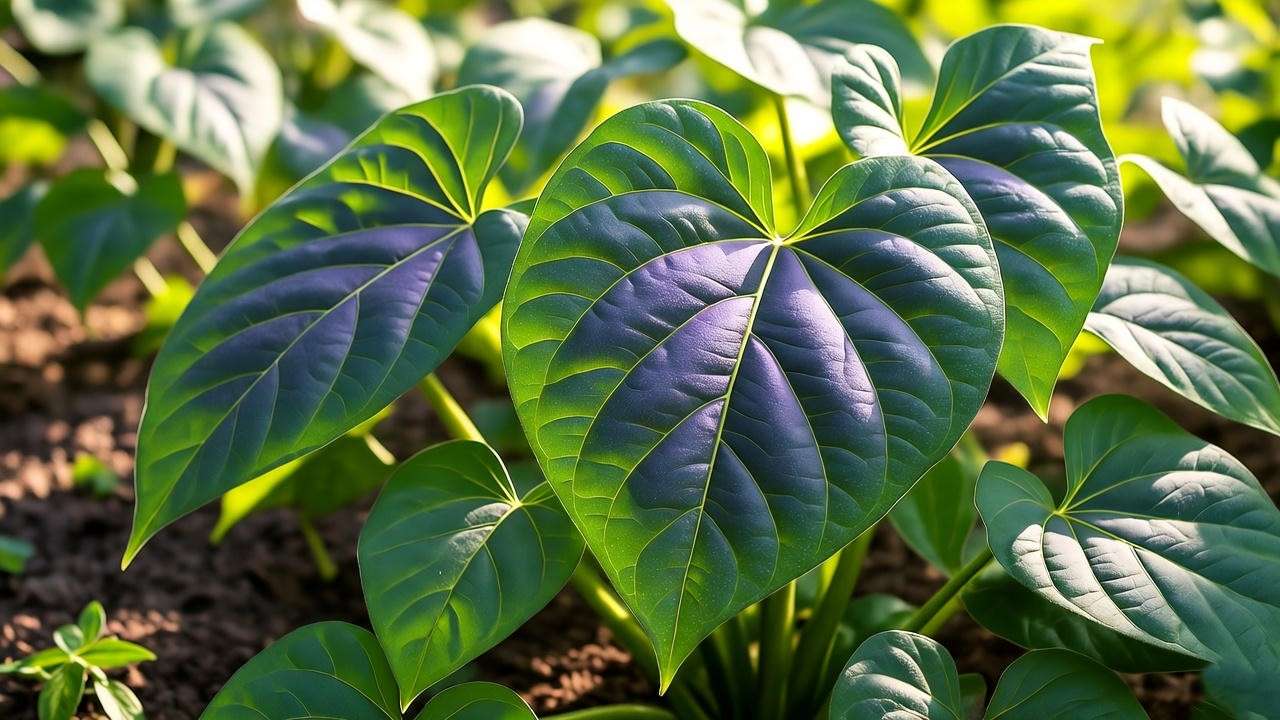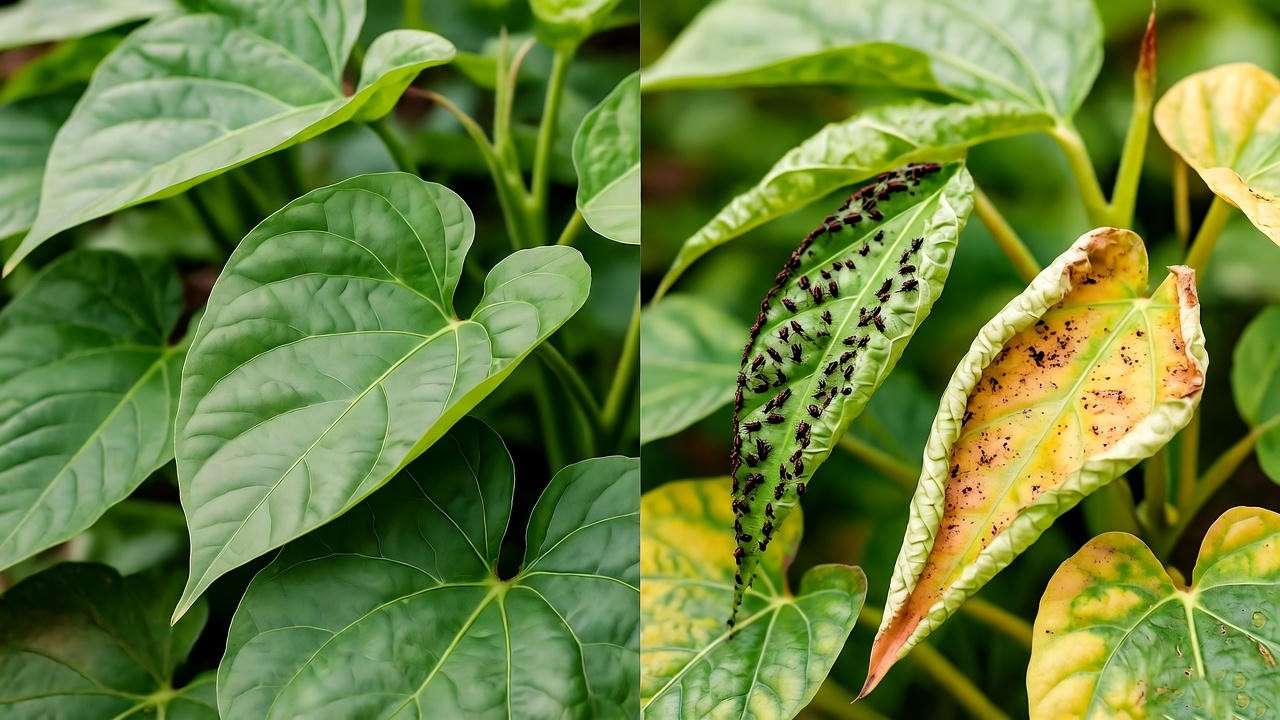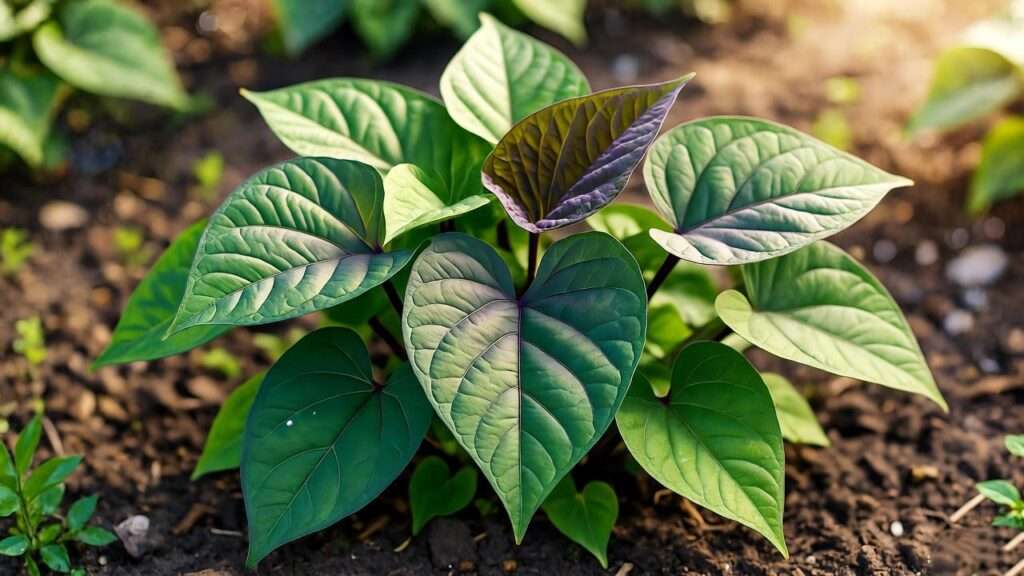Imagine transforming your garden into a lush, green paradise with vibrant sweet potato plant leaves cascading over rich soil, promising a bountiful harvest of nutritious tubers! 🌿 Whether you’re a novice gardener or a seasoned grower, mastering the care of sweet potato plant leaves is the key to unlocking thriving plants and abundant yields. Healthy leaves are the powerhouse of photosynthesis, fueling tuber growth and adding beauty to your garden. Backed by decades of horticultural expertise and research from leading agricultural institutions, this comprehensive guide delivers actionable, trustworthy advice to help you nurture stunning sweet potato foliage. From optimal growing conditions to troubleshooting common leaf issues, this article is your roadmap to success. Let’s dive in and cultivate vibrant growth! 🌞
Understanding Sweet Potato Plant Leaves 🌿
Sweet potato plant leaves are more than just a pretty feature—they’re the engine of the plant’s growth. Understanding their role and characteristics is the first step to ensuring your sweet potatoes thrive.

Anatomy of Sweet Potato Leaves
Sweet potato leaves are broad, heart-shaped, and typically vibrant green, though some varieties display purple or variegated hues. These leaves are the primary site of photosynthesis, converting sunlight into energy to fuel tuber development. Healthy leaves are smooth, glossy, and free from spots or discoloration. They also store nutrients, supporting the plant during stress or nutrient scarcity. According to the University of Florida IFAS Extension, leaf health directly impacts tuber size and quality, making their care a top priority.
Common Varieties and Their Leaf Traits
Different sweet potato varieties exhibit unique leaf characteristics:
- Beauregard: Deep green, heart-shaped leaves with smooth edges, known for vigorous growth.
- Jewel: Medium-green leaves with slight lobes, ideal for temperate climates.
- Okinawa (Purple): Striking purple leaves that add ornamental value and require slightly more sunlight.
These variations influence care needs, such as sunlight exposure or nutrient requirements. For example, purple-leaf varieties often need extra potassium for vibrant coloration.
Why Leaf Health Matters
Healthy sweet potato plant leaves are a barometer of overall plant vitality. They signal whether the plant is receiving adequate water, nutrients, and sunlight. Yellowing, wilting, or spotted leaves can indicate nutrient deficiencies, pests, or environmental stress, all of which reduce tuber yield. By prioritizing leaf health, you ensure robust photosynthesis and nutrient transport, leading to larger, tastier sweet potatoes.
Optimal Growing Conditions for Sweet Potato Plant Leaves ☀️
Creating the perfect environment for sweet potato plant leaves is essential for lush growth and high yields. Here’s how to set your plants up for success.
Sunlight Requirements
Sweet potatoes thrive in full sun, requiring 6-8 hours of direct sunlight daily to support vigorous leaf growth. Insufficient light leads to pale, spindly leaves and reduced tuber production. If you’re in a partially shaded area, position plants where they’ll receive morning sun, as afternoon heat can sometimes cause leaf scorch. To prevent sunburn, gradually acclimate young plants to full sun over 7-10 days, a process known as hardening off.
Soil and Nutrient Needs
Sweet potatoes prefer well-draining, loamy soil with a pH of 5.8-6.2. Heavy clay soils can suffocate roots and stunt leaf growth, while sandy soils may drain too quickly, causing water stress. Test your soil before planting and amend with organic matter like compost or aged manure to improve texture and fertility. Key nutrients for leaf health include:
- Nitrogen: Promotes lush, green foliage but avoid excess to prevent overgrowth at the expense of tubers.
- Potassium: Enhances leaf color and strengthens plant resilience.
- Phosphorus: Supports root and leaf development.
Apply a balanced fertilizer (e.g., 5-10-10 NPK) at planting and again mid-season for optimal results.
Watering Best Practices
Consistent moisture is critical for sweet potato plant leaves, but overwatering can be disastrous. Aim for 1-2 inches of water per week, adjusting based on rainfall. Use a moisture meter or check soil 2 inches deep—if it’s dry, water thoroughly. Overwatered leaves turn yellow and droop, while underwatered leaves wilt and become brittle. Drip irrigation is ideal for delivering water directly to roots, minimizing leaf wetness and reducing disease risk. Mulching with straw or bark retains moisture and keeps soil temperatures stable.

Temperature and Climate Considerations
Sweet potatoes are warm-season crops, thriving in temperatures between 70-85°F (21-29°C). Leaves suffer in extreme heat (above 95°F) or cold (below 50°F). In hot climates, provide afternoon shade to prevent leaf scorch. In cooler regions, use black plastic mulch to warm soil and protect leaves from early frost. For tropical climates, ensure good air circulation to prevent fungal issues. If frost threatens, cover plants with row covers to extend the growing season.
Common Leaf Problems and Solutions 🐞
Even with the best care, sweet potato plant leaves can face challenges. Here’s how to diagnose and fix common issues.
Yellowing Leaves
Yellow leaves often signal nutrient deficiencies, overwatering, or pest damage. Common causes include:
- Nitrogen deficiency: Leaves turn pale yellow; apply a balanced fertilizer or compost tea.
- Overwatering: Soggy soil suffocates roots; improve drainage and reduce watering frequency.
- Pests: Aphids or spider mites can sap nutrients, causing yellowing.
Conduct a soil test to confirm nutrient levels and adjust fertilization. For quick recovery, apply a foliar spray with chelated iron or magnesium. Monitor plants weekly to catch issues early.

Wilting or Drooping Leaves
Wilting leaves indicate water stress, root issues, or heat stress. Check soil moisture first—dry soil calls for immediate watering, while soggy soil requires better drainage. Root rot, caused by fungi like Phytophthora, can also cause wilting. If roots appear brown and mushy, remove affected plants and improve soil aeration. During heatwaves, provide temporary shade with cloth or plant taller companions like corn to shield leaves.
Pests and Diseases Affecting Leaves
Sweet potato plant leaves are vulnerable to pests and diseases, including:
- Aphids: Small, sap-sucking insects that cause curling leaves. Control with neem oil or introduce ladybugs.
- Sweet Potato Weevils: Larvae damage roots, stressing leaves. Use crop rotation and remove plant debris to prevent infestations.
- Fungal Diseases: Leaf spot (Cercospora) and powdery mildew cause spots or white coatings. Improve air circulation and apply organic fungicides like sulfur.
Case Study: A North Carolina gardener reduced aphid damage by planting marigolds near sweet potatoes, attracting predatory insects and saving 80% of their crop.
Environmental Stressors
Strong winds, heavy rain, or poor air circulation can damage leaves, leading to tearing or disease susceptibility. Install windbreaks like fences or hedges in windy areas. Trellising vines improves air flow and reduces fungal risks. Avoid overhead watering to keep leaves dry and healthy.
Step-by-Step Care Routine for Vibrant Sweet Potato Leaves 🌱
A consistent care routine ensures your sweet potato plant leaves stay lush and productive. Follow these steps for success.
Planting Tips for Healthy Leaf Growth
Plant sweet potato slips in spring after the last frost, when soil temperatures reach 60°F (16°C). Space slips 12-18 inches apart in rows 3 feet apart to ensure adequate air circulation. Before planting, root slips in water for 1-2 weeks and harden them off by exposing them to outdoor conditions gradually. Plant in raised beds for better drainage and root development, especially in heavy soils.

Fertilizing for Leaf Vitality
Apply a balanced fertilizer (5-10-10 NPK) at planting to support early leaf growth. Mid-season, side-dress with compost or a low-nitrogen fertilizer to avoid excessive foliage at the expense of tubers. Organic options like fish emulsion or seaweed extract provide micronutrients for vibrant leaves. Avoid fertilizing late in the season to prevent delayed tuber formation.
Pruning and Maintenance
Prune sweet potato vines if they become overly dense, as crowded foliage increases disease risk. Remove damaged or yellowing leaves with clean shears to prevent pathogen spread. Mulch around plants with straw or wood chips to retain moisture, suppress weeds, and regulate soil temperature. Check plants weekly for signs of pests or stress.
Harvesting Without Harming Leaves
Harvest sweet potatoes 90-120 days after planting, depending on the variety. To minimize leaf damage, cut vines back to 6 inches before digging tubers. Use a garden fork to loosen soil gently, avoiding root and leaf stress. Cure tubers in a warm, humid place (85°F, 85% humidity) for 10 days to enhance flavor and storage life.
Advanced Tips for Maximizing Leaf Health 🌟
Elevate your sweet potato game with these expert-level strategies to ensure your sweet potato plant leaves remain vibrant and resilient, even in challenging conditions.
Companion Planting for Leaf Protection
Companion planting can naturally enhance leaf health and deter pests. Pair sweet potatoes with:
- Marigolds: Repel aphids and nematodes with their strong scent.
- Basil: Deters whiteflies and improves soil microbial activity.
- Nasturtiums: Act as a trap crop for pests, drawing them away from sweet potato leaves.
Avoid planting near heavy feeders like corn or sunflowers, which compete for nutrients. A 2023 study from North Carolina State University found that interplanting sweet potatoes with marigolds reduced pest damage by up to 60%, boosting leaf vitality and tuber yield.

Using Technology for Precision Care
Modern tools can take your sweet potato leaf care to the next level:
- Soil Moisture Sensors: Devices like the XLUX Soil Moisture Meter ensure precise watering, preventing over- or underwatering.
- pH Meters: Maintain optimal soil pH (5.8-6.2) for nutrient uptake, critical for leaf health.
- Gardening Apps: Apps like PictureThis help diagnose leaf issues by analyzing photos, offering tailored solutions.
Example: A small organic farm in Georgia used a smart irrigation system to maintain consistent soil moisture, resulting in a 25% increase in leaf vigor and tuber size compared to manual watering.
Organic vs. Conventional Care
Organic methods prioritize sustainability and long-term soil health, while conventional treatments offer quick fixes for severe issues:
- Organic: Use neem oil, compost tea, or beneficial insects like ladybugs for pest and disease control. These methods preserve soil ecosystems and are safe for edible leaves.
- Conventional: Synthetic fertilizers or pesticides (e.g., permethrin for weevils) can address acute problems but may harm beneficial organisms if overused.
Expert Insight: Dr. Jane Collins, a horticulturist at Cornell University, recommends a hybrid approach: “Start with organic practices to build soil health, but keep targeted synthetic options in reserve for severe pest outbreaks.” Always follow label instructions and local regulations when using chemicals.
Troubleshooting FAQs ❓
Here are answers to common questions about sweet potato plant leaves, designed to address reader pain points and enhance understanding.
Why Are My Sweet Potato Plant Leaves Curling?
Curling leaves often result from:
- Pest Damage: Aphids or spider mites suck sap, causing leaves to curl. Inspect undersides and apply neem oil weekly.
- Water Stress: Inconsistent watering leads to curling. Maintain even soil moisture with mulch and regular checks.
- Viral Infections: Sweet potato virus disease can cause curling and stunting. Remove affected plants and source virus-free slips for future planting.
Solution: Diagnose by checking for pests first, then adjust watering. If symptoms persist, consult a local extension service for viral testing.
How Can I Prevent Leaf Spots on Sweet Potato Plants?
Leaf spots, often caused by fungi like Cercospora, thrive in humid, crowded conditions. Prevent them by:
- Spacing plants 12-18 inches apart for air circulation.
- Avoiding overhead watering to keep leaves dry.
- Applying organic fungicides like copper-based sprays early in the season.
Rotate crops annually to disrupt fungal cycles. Regular leaf inspections catch spots early, preventing spread.
Can I Eat Sweet Potato Leaves?
Yes! Sweet potato leaves are edible and packed with nutrients like vitamins A, C, and K. Harvest young, tender leaves and cook them like spinach—sauté, steam, or add to soups. Rinse thoroughly to remove dirt or pests. In many cultures, sweet potato leaves are a staple in stir-fries or curries. Safety Tip: Avoid leaves treated with chemical pesticides unless labeled food-safe.
What’s the Best Way to Store Sweet Potato Slips for Next Season?
To store slips for replanting:
- Select healthy vines from disease-free plants.
- Cut 10-12 inch sections and remove lower leaves.
- Root cuttings in water or moist soil in a warm, bright location.
- Store rooted slips in a cool (50-60°F), humid environment until spring.
Alternatively, store whole tubers in a dry, 55°F space and sprout them 6-8 weeks before planting. This ensures a steady supply of healthy slips for vibrant leaf growth.
Key Takeaways for Thriving Sweet Potato Plant Leaves 📝
- Sunlight and Soil: Provide 6-8 hours of sun and well-draining, nutrient-rich soil (pH 5.8-6.2) for optimal leaf growth.
- Water Wisely: Maintain consistent moisture with 1-2 inches of water weekly, using mulch to retain it.
- Pest and Disease Vigilance: Monitor for aphids, weevils, and fungal spots, using organic controls like neem oil or companion planting.
- Routine Care: Plant properly spaced slips, fertilize with balanced nutrients, and prune sparingly to promote air flow.
- Experiment and Learn: Try companion planting or smart tools to boost leaf health sustainably.
Conclusion
Healthy sweet potato plant leaves are the cornerstone of a thriving garden, fueling robust tuber growth and adding lush beauty to your space. 🌿 By following this guide’s expert-backed tips—rooted in decades of horticultural research—you can cultivate vibrant foliage that supports bountiful harvests. Start today by assessing your soil, optimizing watering, and exploring companion planting. Share your sweet potato success stories in the comments below, and join our gardening community with #SweetPotatoSuccess on social media! For more tips, check out our articles on soil preparation or organic pest control to keep your garden thriving. 🌞













